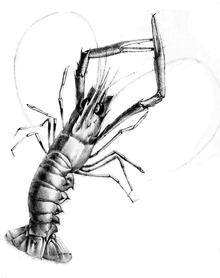Metanephrops challengeri
| Metanephrops challengeri | |
|---|---|
 |
|
| Illustration by C. Spence Bate (1888) | |
| Scientific classification | |
| Kingdom: | Animalia |
| Phylum: | Arthropoda |
| Subphylum: | Crustacea |
| Class: | Malacostraca |
| Order: | Decapoda |
| Family: | Nephropidae |
| Genus: | Metanephrops |
| Species: | M. challengeri |
| Binomial name | |
|
Metanephrops challengeri (Balss, 1914) |
|
| Synonyms | |
|
Nephrops challengeri Balss, 1914 |
|
| External identifiers for Metanephrops challengeri | |
|---|---|
| Encyclopedia of Life | 346024 |
| ITIS | 552935 |
| NCBI | 490590 |
| WoRMS | 382850 |
| Also found in: SeaLifeBase, GBIF | |
Nephrops challengeri Balss, 1914
Metanephrops challengeri (commonly known as the New Zealand lobster or New Zealand scampi) is a species of slim, pink lobster that lives around the coast of New Zealand. It is typically 13–18 cm (5–7 in) long and weighs around 100 g (3.5 oz). The carapace and abdomen are smooth, and adults are white with pink and brown markings and a conspicuous pair of long, slim claws. M. challengeri lives in burrows at depths of 140–640 m (460–2,100 ft) in a variety of sediments. Although individuals can live for up to 15 years, the species shows low fecundity, where small numbers of larvae hatch at an advanced stage.
M. challengeri is a significant prey item for ling, as well as being an important fishery species for human consumption; trawlers catch around 1,000 t (2,200,000 lb) per year under the limitations of New Zealand's Quota Management System. The species was first collected by the Challenger expedition of 1872–1876, but only described as separate from related species by Heinrich Balss in 1914. Although originally classified in the genus Nephrops, it was moved in 1972 to a new genus, Metanephrops, along with most other species then classified in Nephrops.
Metanephrops challengeri is a slender lobster, typically 13–18 centimetres (5.1–7.1 in) long, but exceptionally up to 25 cm (9.8 in), and weighing up to 100 grams (3.5 oz) each. Its chelipeds (legs bearing the main chelae, or claws) are long, narrow, and slightly unequal. The second and third pairs of pereiopods also end in small claws, but the fourth and fifth pairs do not. The carapace is smooth, and extends forwards into a long, narrow rostrum, only slightly shorter than the carapace.
...
Wikipedia

